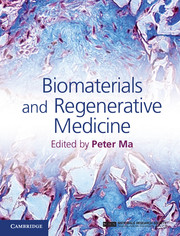Book contents
- Frontmatter
- Contents
- List of contributors
- Preface
- Part I Introduction to stem cells and regenerative medicine
- Part II Porous scaffolds for regenerative medicine
- Part III Hydrogel scaffolds for regenerative medicine
- Part IV Biological factor delivery
- Part V Animal models and clinical applications
- 25 Bone regeneration
- 26 Biomaterials for engineered tendon regeneration
- 27 Advancing articular cartilage repair through tissue engineering: from materials and cells to clinical translation
- 28 Engineering tissue-to-tissue interfaces
- 29 Models of composite bone and soft-tissue limb trauma
- 30 Tooth development and regeneration
- 31 Dentin–pulp tissue engineering and regeneration
- 32 Dental enamel regeneration
- 33 Hair follicle and skin regeneration
- 34 In-vitro blood vessel regeneration
- 35 Stem cells for vascular engineering
- 36 Cardiac tissue regeneration in bioreactors
- 37 Bladder regeneration
- Index
- References
34 - In-vitro blood vessel regeneration
from Part V - Animal models and clinical applications
Published online by Cambridge University Press: 05 February 2015
- Frontmatter
- Contents
- List of contributors
- Preface
- Part I Introduction to stem cells and regenerative medicine
- Part II Porous scaffolds for regenerative medicine
- Part III Hydrogel scaffolds for regenerative medicine
- Part IV Biological factor delivery
- Part V Animal models and clinical applications
- 25 Bone regeneration
- 26 Biomaterials for engineered tendon regeneration
- 27 Advancing articular cartilage repair through tissue engineering: from materials and cells to clinical translation
- 28 Engineering tissue-to-tissue interfaces
- 29 Models of composite bone and soft-tissue limb trauma
- 30 Tooth development and regeneration
- 31 Dentin–pulp tissue engineering and regeneration
- 32 Dental enamel regeneration
- 33 Hair follicle and skin regeneration
- 34 In-vitro blood vessel regeneration
- 35 Stem cells for vascular engineering
- 36 Cardiac tissue regeneration in bioreactors
- 37 Bladder regeneration
- Index
- References
Summary
Introduction
In the USA, 40% of all deaths are caused by cardiovascular disease. More than half of these incidents are a direct result of coronary artery disease [1]. In an effort to decrease the mortality from coronary heart disease, more than 500,000 coronary artery bypass procedures are performed annually [1]. The coronary artery lumen’s inner diameter (ID) is about 4 mm at most, requiring a similarly small-diameter conduit to bypass the blocked artery. The most successful vascular conduit is the patient’s own blood vessel, most commonly the greater saphenous vein in the leg or the internal mammary artery. However, autologous vessels are often unavailable to patients in need of a vascular graft replacement, due to prior harvesting or disease-associated vascular damage.
In search of an alternative vascular replacement, at the beginning of the twentieth century allografts were developed as the first valid vascular replacement. However allografts’ limited long-term success due to aneurysm, calcification, and thrombosis, in addition to low availability and concerns relating to infectious diseases, have hindered their clinical acceptance [2, 3]. The allografts’ shortcomings in small-diameter vascular applications led to the development of synthetic substitutes in the 1950s. Despite the polymers’ thrombogenic surface and lack of compliance, they demonstrated acceptable long-term performance in large-diameter vessels (ID > 6 mm). However, polymeric grafts are inadequate when used in medium- or small-diameter applications.
- Type
- Chapter
- Information
- Biomaterials and Regenerative Medicine , pp. 603 - 620Publisher: Cambridge University PressPrint publication year: 2014



